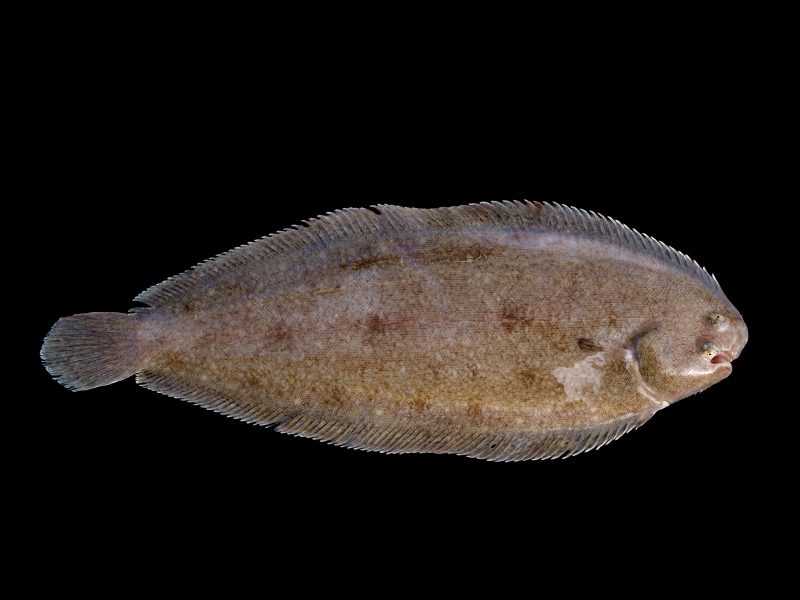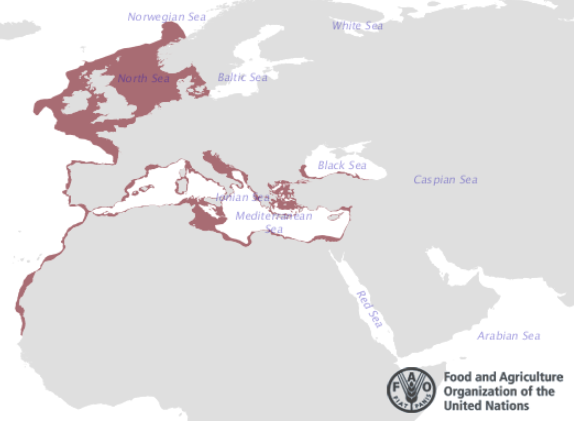Sole

© Hans Hillewaert / , via Wikimedia Commons
Scientific name: Solea solea
Also known as: Common sole, Dover sole, Black sole
MCRS: 240mm
Description
Sole is a compressed flatfish; their eyes are on the right hand side of the head and small hair like fringes on the other side. It is oval in shape and grey to reddish brown in colour on the upper side with dark spots and white on the other side however, their colouration varies with substratum. They have well-developed pectoral fins with a dark spot on the upper pectoral fin. Anal and dorsal fins run the whole length of the body; they are connected to a small tail by a distinct membrane. They can reach 70 cm in length but are commonly between 30 and 40 cm.
Habitat and Distribution

©FAO (Source Accessed 06/04/2018)
Sole are commonly found on sandy and muddy ground and in estuarine habitats where they bury into the sediment. Adults are usually found at a depth range of 10-60m with juveniles staying in shallower water depths of 1-2 m. In winter adults move further offshore and can reach depths of 120 m.
They are present off all coasts around Britain and Ireland and are found throughout the North Sea and western Baltic Sea, the Eastern Atlantic and Mediterranean.
Life Cycle, Reproduction and Feeding
Sole spawn in coastal waters at temperatures of 6-12°C; the time of spawning varies by location. This usually occurs from April – June in the North and Irish Sea and occurs earlier in more southerly areas. Reproduction starts at 3-5 years of ages when they reach 25-30 cm in size but northern populations, in colder environments, mature earlier. Eggs and larvae are pelagic and metamorphose into young sole at around 15 mm length. The fertilised eggs and larvae provide a food source to a wide range of inshore species. Larvae initially look similar to round fish but as they develop they undergo an amazing transformation– whereby one eye migrates round to the same side of the head as the other.
Juveniles live in shallow coastal nurseries for 2-3 years before moving into deeper water. They can undertake extensive migrations as juveniles, this motility deceases as adults and they only make short migrations from feeding to spawning grounds. The common sole is a long lived species, reaching a maximum age of 40 years.
Sole feeds mainly on small crustaceans, worms and small soft shelled bivalves as well as molluscs and other small fish. They are mostly inactive during the day and usually feed at night but can feed during the day in highly turbid conditions.
Additional Information
There are over 180 species which are members of the Solidae family around the world, in the UK the common sole and the lemon sole are the most commercially important.
In the NWIFCA District
The common sole is a valued food fish and therefore important for commercial fishers and recreational anglers. Sole is fished commercially with demersal otter trawls, gill and trammel nets and recreationally using rod and line, the species is small mouthed so small hooks and baits are necessary. Sole tends to school in groups in deeper water making it easy for commercial trawlers to catch the fish in large quantities. They are more active at night so trawling activity is concentrated at this time. As soles move inshore in the summer months, netting for the species increases in summer. Anglers can also catch the species from the shore at this time however sole in shallow waters are likely to be either juveniles or breeding adults. In the Irish Sea stocks have been depleted in the past however it appears a slow recovery is taking place.
Fisheries Management
Within the district there are Byelaws to restrict the use and dimensions of nets and trawls. These vary in different location throughout the district. To read more about this click here.
Where commercial trawling and netting occurs in Marine Protected Areas it undergoes an assessment to ensure the activity does not cause risk to conservation features. HRAs carried out for trawling and netting in the District’s European Marine Sites can be found here.
There are also national and international measures that apply to this fishery, an annual total allowable catch (TAC) has been set for the species. TACs are divided up at an international level in the form of quotas, and boats that are eligible are given a proportion of this quota and can fish for the species. Once the available quota has been fished the fishery is closed. To read more about this click here.